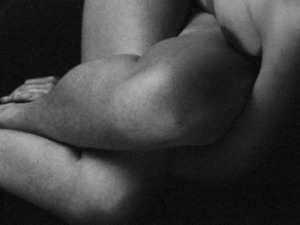Heidekolb's Blog
On Not Writing and Missing Parts ~ Jungian Reflections
5 Comments
Why has it been years since my last entry? As so often with our actions, or lack thereof, motivations are not always easily brought to the forefront, often buried beneath rationalization and explanations.
To some extent I experienced and saw in others the effects of a not insignificant over-stimulation triggered by the daily bombardment of words and images accelerated by the increase of social media. A digital whirlwind blowing us away. What could in proper measure inspire and connect became an instrument of confusion and destabilization. Too many images, too many words, too many opinions, each one claiming a sense of righteousness
Why contribute to the clutter?
We don’t know what to take in any longer in our era of fabricated facts, fake news and deliberate manipulation in the service of some clever marketing scheme.
Our inner landscape often does not provide much help either. Our fragmented selves, each part with their own “voice” pull us in different directions. The outer and at times inner voices as well have become a shrieking and painful cacophony. Where is the center? Where is the orient?
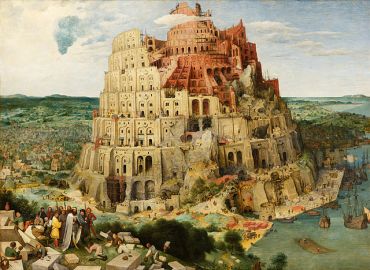
Pieter Bruegel, the Elder ~ The Tower of Babel (1563)
So much noise, so little listening, so little worthwhile to hear. Uncertain times.
Why bother writing?
A few months before the catastrophe of World War I began in 1914 Jung looks “into the depths of what is to come” and describes his vision of “the enormous dying and the sea of blood”…..A darkness seized the world, the terrible war arose…And so we had to taste hell. (Red Book, p.274)

Civil War victims in Syria ~ People and children massacred in Ghouta by chemical attack, 2013 (Wikipedia)
Jung continues: “I saw which vices the virtues of this time changed into, how your mildness became hard, your goodness became brutality, your love became hate, and your understanding became madness. Why did you want to comprehend the darkness! But you had to or else it would have seized you. Happy the man who anticipates this grasp….You are completely alone in this struggle, since your Gods have become deaf.”
The felt appreciation of how much life needs death is one of the cornerstones of Jungian thought. Death, not as an abstract concept but as a deeply felt reality expressed as empathy for the other, in all its manifestations, human, animals and other life forms. Gaia herself. And eventually also, we may open up to our own suffering as irrelevant and small, so our heads want to tell us, it may appear compared to the attacks we inflict and witness on the screens that have become our reality-shaping tools.
I began to wonder if I had answered my question of why not writing for so long. Probably, to some extent. But one answer is never the full picture. Easy to forget, hard to practice. More digging in silence. Sitting with nothing.
Often it is helpful to revisit the “crime scene”. In my case, I reread my last entry from. “A Dangerous Method ~ The Movie~ Part I”. Part II was never written. The “why not” is only speculation. I was not ready. I did not what it was. Who knows. But “it” knew and “it” had to patiently wait until I was ready to hear it. I now know what could not be written then. Part II is the tragic story of Sabina Spielrein.

Sabina Spielrein 1918
I am grateful to my colleague, Jungian analyst Ilona Melker who has done extensive research on Spielrein and who confirmed for me in her unpublished presentation at the Jung Foundation how much Spielrein was not only used as a muse by both Freud and Jung (even that without any acknowledgement, as Melker points out) but how many of her findings were appropriated and contributed to the emerging theories of both Freud and Jung. How closely her ignored paper “Destruction as the Cause of Coming into Being” is related to Jung’s understanding of transformation and how much life needs death to renew itself and to Freud’s concept of the death instinct. Acknowledged only in footnotes. Sabina Spielrein, a pioneer and one of the first female psychoanalysts perished together with her two daughters, both of whom were talented musicians. They were shot dead along with the many thousands of Jewish residents by an SS squad in 1942.
Women as footnotes. We tend to oscillate between how much has changed and our denial of what has not. We are entering a new political climate with renewed hostility towards the feminine and psyche, and therefore also on women as the main carriers of projections of the feminine. All are under renewed attack by a now seemingly institutionalized form of greed and indecency by a changed and potentially dangerous political atmosphere, where climate change denial, ruthless exploitation of the planet’s resources, attacks on women and anyone who fits the definition of “the Other” are fighting to become the new normal. From demanding obedience to the law without pondering questions of ethics and morals.
Patriarchy is a dying. But not dead yet. It may take a few more generations. We are in the midst of a political backlash to prior attempts towards a more integrated culture. Authoritarian structures wrestle for the upper hand. If we can, we need to be vigilant. If we can, we need to show up with a voice. But if the voice is not there yet, if we cannot yet hear what needs to be said, then we need to sit patiently until we can hear what needs to be said.
And then, if one can tolerate the passing of time without judgment and surrender to the timeless nature of psyche, deo concedente, a word, a thought appears that wants to become flesh.
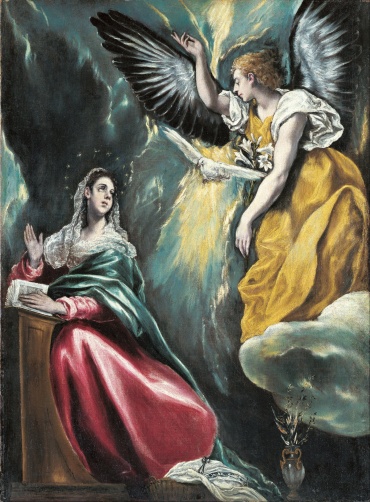
The Annunciation by El Greco
Tags: C.G. Jung, Freud, image, Sabina Spielrein, society, women, word, writing
A Dangerous Method ~ The Movie ~ Jungian Reflections, Part 1
5 Comments
Please go and see this movie > adangerousmethod ~ It is a good one. I know I will see this film more than once. There is such a richness to it. It takes us back to when it all began. It takes us back to the old world of Victorian Vienna and Zurich, a period of suffocating moral constraints, yet also a period that brought forth new manifestations of a changing consciousness. It takes us back to a time before Jung was Jung, when Freud was the enfant terrible of Viennese’ medical world and that mysterious, and yes, most dangerous method of what eventually became the talking cure of Freud’s psychoanalysis and Jung’s analytical psychology were still a bloody mess. David Cronenberg, the movie’s director, provides us with a glimpse into the labor pangs of one of the most important cultural events of the 20th century, the birth of the therapeutic, analytic relationship, albeit an endangered species today.
 Freud, Spielrein and Jung, portrayed by Viggo Mortensen, Keira Knightley and Michael Fassbender
Freud, Spielrein and Jung, portrayed by Viggo Mortensen, Keira Knightley and Michael Fassbender
The film introduces us to these three players of this birthing process. While Freud and Jung are household names in psychological circles, very few are aware of how Sabina Spielrein contributed to the formulation of psychoanalytic theory. After all, she was not only a woman, but also a sick and troubled patient. It is much less known that she eventually became one of the first female psychoanalysts and that as muse for both men, she not only inspired significant ideas in their theories, but may have in fact verbalized important concepts for the first time, without ever being credited for any of them.
I attended a screening of this film. David Cronenberg was present for a Q & A. In one of his comments he remarked on how he was primarily interested in showing that new relational territory Jung had entered with his patient/most likely lover Sabina Spielrein. Cronenberg was not interested in elevating or demonizing any of the players of that curious love triangle. It seemed he rather payed homage to Jung’s and Spielrein’s courage as they stumbled and fell into their desires and fears lurking out of the recesses of their psyches.
They did not yet know what they were getting into as Jung put Freud’s theory into practice. Boundaries were not yet clearly delineated of what was to become the sacred, precocious and highly dangerous space of the analyst/patient relationship. May we withhold all judgment for now, as Cronenberg did so beautifully in his film, and simply honor the courage and tricksterish folly as Jung and Spielrein ventured deeper into new territory of their inner landscape.
A unique relationship develops as patients dare to find words for the images sent forth from their psyches’ secret chambers. The analyst must follow and relate without judgment. The process of following and relating in earnest will take the analyst to unknown, possibly frightening and dangerous places within himself. This is the nature of the work. It is its excitement and its danger.
This openness towards another is erotic in its truest sense. Yet we must remember that Eros is a god, an archetypal force, that can and often does wreak havoc with our minds and personas, especially if they are built on the shaky grounds of collective values.
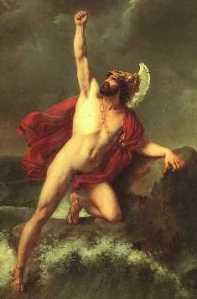
The psychoanalytic relationship has become much more refined but has also lost much zest and verve since its early inception. We do know now that sexual contact with patients causes tremendous, sometimes irreparable harm to their psyches and is to be resisted at all cost, even if desired and initiated by the patient. (I believe this to be true not only for psychoanalysts, therapists, but for most teachers, mentors, practitioners and “gurus” of all creeds). Yet while the concrete enactment must be denied, the often heart and gut wrenching power of eros, which may or may not manifest in a sexual way, needs to be consciously held, sometimes even suffered in any analysis worth its salt. But without love there is not much chance for transformation. Yet the shadow of authentic eros is power driven predation and the field of psychotherapy has seen its fair share of it, and still does in many ways.
There is much to learn from the courage and mistakes of our analytic ancestors. It takes courage to see and be seen and to relate and accept what is within ourselves and the other. Mistakes will happen in all our relational lives, inside and outside the consultation room. It takes even more courage to acknowledge them as such.
Salute to the bravery of all the seekers, patients and analysts, analysts and patients as they subject themselves to mutual scrutiny.
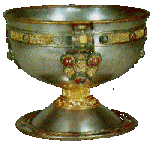
The film is based on John Kerr‘s scholarly and carefully researched book with (almost) the same title ~ A Most Dangerous Method ~ an excellent book, I highly recommend it.
For those who wish to dive deeper into the history of psychoanalysis I suggest, The Discovery of the Unconscious by Henri Ellenberger.
A Little Help From a Master ~ Jungian Reflections
3 Comments
A few days ago I was in the presence of a master. These occasions do not happen all that often. I was lucky to have had a chance to be present at a dharma talk with Thich Nhat Hanh, the 85 year old Vietnamese Zen master, who was one of the founders of the “Engaged Buddhism” movement. Something happens when one is in the presence of a genuine master. At least if one can show up with some degree of openness and a willingness to receive. This something that happens is a transmission. Transmission can only originate from someone whose knowledge is rooted in lived experience and has become anchored in the tissues and bones of the physical body. We are then in a realm that transcends bookish knowledge gathered in purely academic pursuit. There is a moment when consciousness permeates every cell and lightens up one’s awareness. Consciousness can shine brightly. We are humbled and grateful for we know then, we are in the presence of a master.
 This level of consciousness is usually hard-earned. It is life’s gift after much inner work, focused concentration and often much emotional suffering. It comes like an unexpected embrace by Sophia, the personification of divine wisdom. It is the relief of dew drops calming parched skin. Surely one gets there only on one of the roads less traveled. “Stop thinking”, Thich Nhat Hanh says, “and relax”. Relax down into your bones, because without that deep relaxation one is not able to receive, not what is “out there” nor the images and guidance we all have available from within. ~ Exhale, relax, let go ~ that is a good start for all things.
This level of consciousness is usually hard-earned. It is life’s gift after much inner work, focused concentration and often much emotional suffering. It comes like an unexpected embrace by Sophia, the personification of divine wisdom. It is the relief of dew drops calming parched skin. Surely one gets there only on one of the roads less traveled. “Stop thinking”, Thich Nhat Hanh says, “and relax”. Relax down into your bones, because without that deep relaxation one is not able to receive, not what is “out there” nor the images and guidance we all have available from within. ~ Exhale, relax, let go ~ that is a good start for all things.
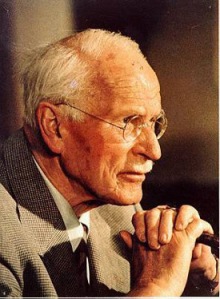 When asked what religion I follow, I like to answer with, “I am a Jungian”. That allows me to make room for spirituality, for what is larger than human life and ego consciousness, without getting caught in any dogma. The notion of transmission makes sense if we allow for the possibility of an interconnected universe in which nature and psyche are embedded. This was Jung’s vision and with this appreciation the mysterious processes of synchronicity and transmission fall into sync. The necessity for transmission may have been at the root of Jung’s requirement, in which he differed from Freud, that all Jungian analysts-in-training undergo a thorough analysis. He knew that we can accompany the individuals entrusted in our care only as far and deep as we ourselves have dared to venture. Jungian training worth its salt must not err on the side of prioritizing academic achievements, but maintain a vestige in the ancient tradition of mystery schools.
When asked what religion I follow, I like to answer with, “I am a Jungian”. That allows me to make room for spirituality, for what is larger than human life and ego consciousness, without getting caught in any dogma. The notion of transmission makes sense if we allow for the possibility of an interconnected universe in which nature and psyche are embedded. This was Jung’s vision and with this appreciation the mysterious processes of synchronicity and transmission fall into sync. The necessity for transmission may have been at the root of Jung’s requirement, in which he differed from Freud, that all Jungian analysts-in-training undergo a thorough analysis. He knew that we can accompany the individuals entrusted in our care only as far and deep as we ourselves have dared to venture. Jungian training worth its salt must not err on the side of prioritizing academic achievements, but maintain a vestige in the ancient tradition of mystery schools.
Jungian thought at its core opens up a deeply spiritual realm. But just as Thich Nhat Hanh’s “Engaged Buddhism” is a lived practice aimed at building compassion and easing suffering to make this world a better place for all, Jungian thought, if it is to be worth its salt, also must be a practice, but one with a very different focus. Jung, being a true steward of psyche, stayed away from all moral demands. His vision was a holistic one. His focus was individuation, which means becoming more fully oneself. This is not a form of perfectionism but completeness. It requires finding ways of dealing with all forces, positive and negative, light and dark, within oneself and in the collective, the world at large. This is why Jungian work at its core is always shadow work. And there is always more to come, as the Shadow, being archetypal, can never be fully integrated. Yet, as Jungians we soldier on and journey towards a greater degree of relating to that that we do not wish to be or that that we cannot fathom to also be part of who we are. As Jungians we train our eyes to see into and withstand the darkness. Welcome to another road less traveled.
 It is a dangerous road. Nietzsche did well by reminding us of its danger: “Battle not with monsters, lest ye become a monster and if you gaze into the abyss, the abyss gazes also into you”. Yet it can be done. Seeing Thich Nhat Hanh I knew it was possible to understand and suffer the darkness without being overtaken. I knew because it was transmitted. The diligent practice of mindfulness, as championed in the Buddhist tradition, develops our capacity for compassion. It strengthens our emotional heart and quite possibly our physical heart as well.
It is a dangerous road. Nietzsche did well by reminding us of its danger: “Battle not with monsters, lest ye become a monster and if you gaze into the abyss, the abyss gazes also into you”. Yet it can be done. Seeing Thich Nhat Hanh I knew it was possible to understand and suffer the darkness without being overtaken. I knew because it was transmitted. The diligent practice of mindfulness, as championed in the Buddhist tradition, develops our capacity for compassion. It strengthens our emotional heart and quite possibly our physical heart as well.
Jungian work is very much the development of a unique art of seeing and perceiving. One eye is directed towards the Shadow in its many manifestations in our personal lives and in the injustices and cruelties of society, yet the other eye must learn to hold the vision of our heart’s deepest values and feelings. The more we individuate, the more we will care and feel for the world around us. Individuation takes us into the world, our communities, dissolves imaginary boundaries of race, gender, nationality and creed. Individuation allows us eventually to relate to all sentient beings and to even expand our awareness into the world of so-called inanimate matter.
It may not be the only way, but Thich Nhat Hanh’s way of generating peace and reconciliation provides tools and techniques to develop the compassion necessary for the daunting path of facing the never ending Shadow without getting lost in it. I for one am deeply grateful that I had a chance to experience in person this humble monk yet great Zen teacher whose writings have provided me with much solace over the years. Grateful.
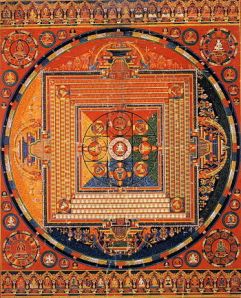
For more information on Thich Nhat Hanh and his work please visit plumvillage.org
The Psychotherapist as Hitchhiker in the Realm of Psyche ~ A Jungian Perspective
5 Comments
It has been awhile. I could think of numerous reasons why I had not been writing. At least one of them pertains to the subject matter stirring in me. How does one communicate what happens in the sanctum of psychotherapy? By definition we therapists are in the background, from the Freudian notion of the therapist as a “blank screen” to modern day issues of confidentiality, therapists have become accustomed to not talking about their experience, of what they “see” while they sit there, hour after hour, in their consultation rooms, which more often than not turn into battlefields of forces and energies larger than any individual. Welcome to my world.
 If alchemy is the art of seeing, then Jungian analysts are the alchemists among the practicing scientists of the soul. The best ones of us “see” energy. It is a kind of imaginal seeing, that can take various forms, depending on typology and personality of the practitioner. Even a subtle physical, bodily sensation can be experienced as a psychic image with meaning. From this perspective, an image can be a thought or a sound, a memory, any kind or perceptive experience, which is felt and entered into with the purpose of extracting its essence in that very moment.
If alchemy is the art of seeing, then Jungian analysts are the alchemists among the practicing scientists of the soul. The best ones of us “see” energy. It is a kind of imaginal seeing, that can take various forms, depending on typology and personality of the practitioner. Even a subtle physical, bodily sensation can be experienced as a psychic image with meaning. From this perspective, an image can be a thought or a sound, a memory, any kind or perceptive experience, which is felt and entered into with the purpose of extracting its essence in that very moment.
Jungian analysts go through a rigorous training for many years to train their bodies and minds to become finely tuned instruments, which can translate vibrational energy into felt psychic images. And thus the weaving of a new story begins….
Each person is its own universe. We are all fundamentally the same while also entirely unique. Unless pathologically stuck, our personal psyche reflects the movements and dynamics of the larger, cosmic, archetypal psyche. The constellations and dynamics of our inner world, which manifest in our moods, thoughts, perceptions and images reflect the movement of this larger autonomous psyche at any particular moment in time. Wake up ~ for we are indeed participants in a cosmic and divine drama.
Jung said “The meeting of two personalities is like the contact of two chemical substances; if there is any reaction, both are transformed”. In the course of a day’s work, I may consult with anywhere between four to eight people. That is four to eight unique psychic constellations. It is as if I were taken to a different universe each time a new patient walks into the room. Initially our main task as therapists is to be open and perceptive to the energies entering the space. We observe the images and their feeling tone as they emerge in us triggered by any new person in the room. I remain truthful to classical analytical tradition when I borrow the analogy of the analyst as the vagina, open, receptive and permeable.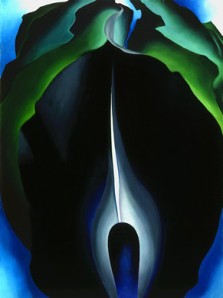
But the scene changes with every hour, with every new patient. The analyst is a hitchhiker on a zigzag ride within the great autonomous psyche.
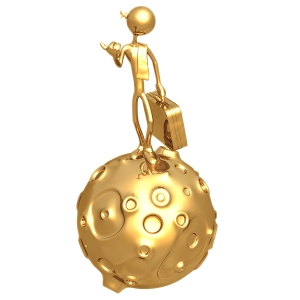
Whenever a new patient walks into the room, it is as if I am invited to step into an imaginal cab, which takes me to a different spot in the vast landscape of psyche. A spot where the personal and the archetypal psyche meet and which reflects a snapshot of the process towards consciousness of this particular person at that very specific point in time. We may think of Rupert Sheldrake’s “morphic field and resonance”, which postulates that there is a mode of transmission of shared informational aka archetypal patterns.What initially begins as an account of a very personal struggle and cause of suffering reveals itself as an aspect of a cosmic drama hidden behind the facade of mundane problems. 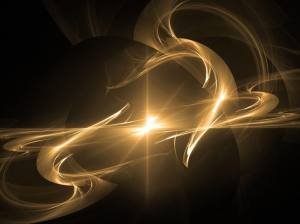 In this scenario I am invited to observe and participate with the entirety my being in a story that enfolds in the form of images, feelings and bodily sensations. At the end of the day, all we are left with is our own process of making sense of and participating in life. Those of us psychotherapists, Jungian or otherwise, who understand that we are stewards of psyche appreciate the privilege of being allowed into the process of another individual.
In this scenario I am invited to observe and participate with the entirety my being in a story that enfolds in the form of images, feelings and bodily sensations. At the end of the day, all we are left with is our own process of making sense of and participating in life. Those of us psychotherapists, Jungian or otherwise, who understand that we are stewards of psyche appreciate the privilege of being allowed into the process of another individual.
Nietzsche noted in “Beyond Good and Evil” that “he who fights with monsters should be careful lest he thereby become a monster.” I think Jung would have agreed. Both, Freud and Jung, were very much aware of the destructive forces in psyche and nature. There is an innate inertia, an inborn pull which wants to prevent consciousness at all cost. This force is the hero’s enemy and sometime nemesis. This is the battle the hero has to fight. We all have to fight this battle, day in and day out. The road towards consciousness is not only full of twists and detours, it is paved with often seemingly insurmountable obstacles. These are the monsters and knife wielding intruders of our dreams. Many of these images represent psychic contents which can be integrated, battles which the ego can win, but there may also be an archetypal treacherous anti-life force which is beyond integration, at least at this stage of our psychic evolution.
Here we can add another descriptor to what the depth-psychologist is ~ a hitchhiker, a steward, but also a warrior. For battle we do, with and for our patients. Not with advice and not with smart (if we are lucky) interpretations, but by joining our patient in the abyss of their experience, by confronting the monstrous mirror-images in our own psyche and by tending to, the sometimes viciously attacking, energies constellated in the field. Winning a battle here usually means not being sucked into its devouring vortex. Heroically staying two steps ahead of a flood that threatens to drown consciousness.
And then the day ends and my last patient is leaving the office. I emerge out of the shared spaces. It takes some time to develop a sense of my own psychic contours again. I reflect on the day and all the places I was taken to in that familiar yet different universe of the other person. And yes, viewed from the outside, I was just sitting there.
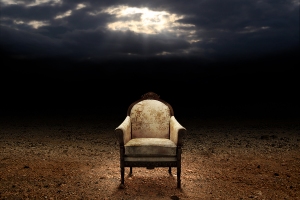
In the Beginning there was the Word ~ C.G.Jung-The Red Book Reflections
11 Comments
I am not a great believer in words..but I guess the more people believe in words the more powerful they can be.. (thank you Mona K). I came across these words in my twitter stream just as I pondered Jung’s imaginal encounter with “the Anchorite” in the Red Book (RB), in which the two of them discuss the meaning of words.
We are shaped by the spoken and, to even a greater degree, by the written word.

The Anchorite (an inner, imaginal figure) speaks to Jung: “Surely you know that one can read a book many times – perhaps you almost know it by heart, and nevertheless it can be that, when you look again at the lines before you, certain things appear new or even new thoughts occur to you that you did not have before”.
What is suggested here is to appreciate the “word” as a symbol and not as a sign with a definitive, unmovable meaning. A symbol is a door into the unknown and language, the word, can be such a portal. We all the know the power of poetry or of a book that transported us into another world. A good piece of writing can take us to very unexpected places, if we allow it to happen. “A succession of words does not have only one meaning. But men strive to assign only a single meaning to the sequence of words, in order to have unambiguous language”, the Anchorite proclaims.
Like a tightrope walker we are asked to perform a delicate balancing act. Words and language allow us to grasp and assimilate the nature of reality. It is hard to detach the word from human consciousness. “What was word, shall become man. The word created the world and came before the world. It lit up like a light in the darkness“, Jung writes. He also says that “this striving is worldly and constricted” and the mysterious addition that this striving “belongs to the deepest layers of the divine creative plan”.
Words and language allow us to grasp and assimilate the nature of reality. It is hard to detach the word from human consciousness. “What was word, shall become man. The word created the world and came before the world. It lit up like a light in the darkness“, Jung writes. He also says that “this striving is worldly and constricted” and the mysterious addition that this striving “belongs to the deepest layers of the divine creative plan”.
Initially the limited, narrow range of meaning provides security. We need to believe the illusion that we know what is what. Jung writes, “the unbounded makes you anxious since the unbounded is fearful and humanity rebels against it”.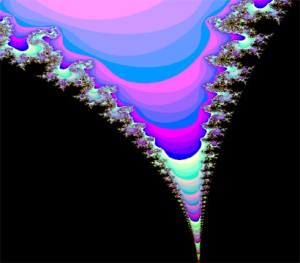
The paradox: We must build walls of meaning in order to emerge as conscious beings out of the chaos, but then these very walls must be broken down, because “words should not become Gods”.
One way of measuring ego-strength and maturity of personality is to assess a person’s capacity to tolerate ambivalence. This capacity is closely related to the ability to feel empathy. It is all about tolerating otherness. Empathy is the genuine ability to see the world through the eyes of another. Another who is truly different, someone who cannot be easily understood. It takes effort (and ego-strength) to make room for another standpoint, another meaning. There are many ways to be right. We have reached maturity when we can give up tour need to be right without losing ourselves and our values.
Imagine ~ making room ~ imagine that the entire universe is within you and every person, every other living creature is a parallel universe ~ no either/or, no right or wrong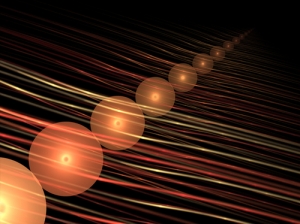
“He who breaks the walls of words overthrows Gods and defiles temples”, Jung writes. We need to break down the prison of stale and empty words. We need to dismantle inherited belief systems, which have lost the spark of life. We need to give up the delusion that a word in itself represents truth. It does not matter whether the word is in the Bible or in another writing considered sacred, in your favorite novel, on the internet or in one of our ingrained thought patterns. The word may give us temporary security. That may be necessary for some time. But the evolution of consciousness cannot be stopped, it can only be resisted, which makes it harder. The evolutionary trajectory of life pushes us towards new meaning. Meaning full of juicy freshness and uniquely individual. This is what Jung’s entire life’s work was about. But this encouragement comes with a warning. Jung writes: “But no one should shatter the old words, unless he finds the new word that is a firm rampart against the limitless and grasps more life in it than in the old word”. We find this over and over again in Jung’s work. Jung who parted ways with Freud, because he believed that the unconscious did not only need to be tamed, but was also the source of rejuvenation and great treasures, was also acutely aware that its forces were so powerful that it could sweep us into the chaos of psychosis at any time.
The word is a container and a prison. We need to find the balance on the tightrope. Words, stories, narratives create our lives. As we grow, our stories, memories and narratives can change. Are our narratives, the way we think about ourselves still true? Are they still meaningful in the sense that light and life are pulsating through them? Or do they need to be shed like a serpent leaves its old skin behind? Nothing is forever. We are always becoming.
Nothing is forever. We are always becoming.
On Samhain, Archetypes and Psyche’s Experience of the Nurturing Darkness ~ The Red Book Reflections
11 Comments
Every year I lament the end of summer. Until about this time of the year, when I can sense a major shift of energy. Darkness is settling in. There are so many shades of darkness. I will single out one for today. It is the shade that belongs to Samhain, one of the great doorways into the dark.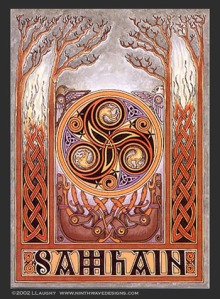 Tradition has it that the veil between the upper and the lower worlds is the thinnest on the night of October 31 to November 1st. It is a night of welcoming and honoring the dead. In the old days it was a time of divination and communication with the spirit world. It is the beginning of the new year, because the Celts appreciated that new life begins in utter darkness. Although originating in the pre-Christian Celtic tradition, Samhain belongs to all people who are open to the cycles and movements of nature.
Tradition has it that the veil between the upper and the lower worlds is the thinnest on the night of October 31 to November 1st. It is a night of welcoming and honoring the dead. In the old days it was a time of divination and communication with the spirit world. It is the beginning of the new year, because the Celts appreciated that new life begins in utter darkness. Although originating in the pre-Christian Celtic tradition, Samhain belongs to all people who are open to the cycles and movements of nature.
Let us understand the meaning of Samhain from a Jungian psychological perspective. Maybe because our culture has lost the connection to the natural and nurturing aspect of the dark, we are currently so terribly dominated by the devouring and destructive side of it. The darkness of Samhain is of an introspective, reflective nature. Qualities our dominant culture is not supporting. Imagine, letting go of all the noise, the distractions. Imagine, allowing yourself t be alone ~ with yourself, only your breath leading the way.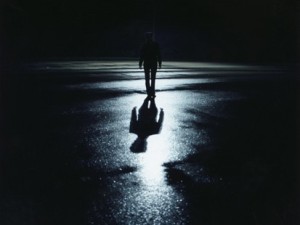 All fears and resistances belong to the ego, which initially refuses to acknowledge the existence of another realm of reality. The natural world knows no such fears. Imagine, walking into the darkness of not yet knowing ~ and listening, and seeing.
All fears and resistances belong to the ego, which initially refuses to acknowledge the existence of another realm of reality. The natural world knows no such fears. Imagine, walking into the darkness of not yet knowing ~ and listening, and seeing.
The dead come to visit in this night, it is said. They may come with messages or they simply need us to acknowledge their existence. The knowledge, but also the sins and wounds of our ancestors live within us. This is a psychic fact that C.G. Jung very much understood. Psychic life, the life you and I know and experience, emerges out of and continues to be embedded in an archetypal field. Archetypes are ultimately unknowable but very specific patterns of energy which we experience as images and affects. Our relation to the archetypal world connects us to our ancestral history, including our animal and microbial past. Yes, that far back can psyche reach. An archetype is like an old watercourse along which the water of life has flowed for centuries, digging a deep channel for itself, Jung writes. If we manage to quiet the chatter within us, then the world of the forgotten past within us will be at its most available tonight, according to the tradition of Samhain.
If we manage to quiet the chatter within us, then the world of the forgotten past within us will be at its most available tonight, according to the tradition of Samhain.
But we do not have to peer that far. In the shadow that we carry are also all the traumas, wounds and unresolved issues of our recently deceased relatives, parents and grandparents. I have learned (thank you Malidoma Some : ) that the departed souls of our relatives need us as much as we need them. There is a unique power of healing that only our waking consciousness can generate. Some of us are plagued with psychological disturbances, which we have psychically inherited from those close to us who have died. Every unresolved trauma or other unresolved psychic issue is passed on from one generation to the next, until the chain is broken. Breaking the chain means bringing the dark into light, making what has been unconscious conscious. That is the job of the living and only we can do that. That is our purpose in life.
Jung writes in the Red Book (RB) “If you live your own life, you do not live the common life, which is always continuing and never ending, the life of history and inalienable and ever-present burdens and products of the human race”. Before we can become who we are meant to be, before we can live our own life, we must descend into the shadow left by those who have gone before us.
If we surrender to the natural movement of the soul, we can and must bring forth pieces of the personal and collective unconscious that need to come into the light. This is growth. This is healing. This is becoming.
The sheer beauty of Jung’s writing in the RB shines forth in this quote and elucidates this thought. See it, hear it with your senses open to the ever-present symbolic reality: ” As a drop in the ocean you take part in the current, ebb and flow. You swell slowly on the land and slowly sink back again…you wander vast distances in blurred currents and wash up on strange shores, not knowing how you got there. You mount the billows of huge storms and are swept back again into the depths….You had thought that your movement came from you and that it needed your decisions and efforts….but with every conceivable effort you would never have achieved that movement and reached those areas to which the sea and the great wind of the world brought you..
From endless blue plains you sink into black depths; luminous fish draw you, marvelous branches twine around from above. You slip through columns and twisting, wavering, dark-leaved plants, and the sea takes you up again in bright green water to white, sandy coasts, and a wave foams you ashore and swallows you back again, and a wide smooth swell lifts you softly and leads you again to new regions, to twisting plants, to slowly creeping slimy polyps, and to green water and white sand and breaking surf.”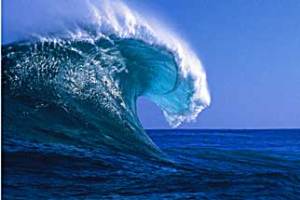
At Samhain the veil may be the thinnest, but the work of connecting to the ancestors, of acknowledging the archetypal realities is not over when this sacred night has passed. But it could be the beginning of a new attitude.
Samhain has turned into Halloween. We have learned to slip into a disguise, so we are not recognized by the wandering “evil” spirits. But maybe we want to remember some of the old ways and honor the dead. As Jungian warriors we may want to sit quietly and reflect on what has died within us, what traumas have we inherited from our personal and collective ancestors. What is it in our lives that needs to be faced and owned? Who are the hungry ghosts in our soul? How can their energy be released and transform in the light of consciousness?
Sit quietly ~ there is work to be done on your journey of becoming and it begins in the darkness of this night.
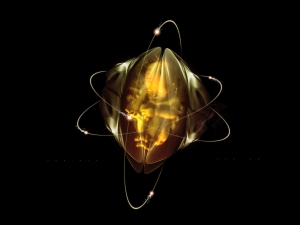
A Blessed Samhain to All
For all new life forms in the dark.
Bluebeard ~ A Killer to reckon with: How to Survive the Soul’s Predator
11 Comments
If you think the human psyche is home to nothing but goodness and beauty, then please step aside. Because if you continue reading, you might get upset. For we shall dive into a reality that is hard to grasp by nature. It is elusive, slippery, and does not want to be seen. It feels counter-intuitive and anti-life. It is indeed both.
There is an innate predator and killer in psyche. A psychic force that cannot be “rehabilitated”. A psychic force that does not transform. The challenge with all archetypal energies is to learn how to relate to them without being overtaken. For the feminine psyche, which always wants to connect and relate, this anti-life force is probably the most difficult one to come to terms with. It is too much for an individual psyche to digest. 
This is the realm of Freud’s Thanatos and Jung’s dark side of the Self. These are the closest psychological images for psyche’s experience of something “evil”. Like all creatures, the human creature must also learn that there are predators, out there and within us.
The mythical imagination has always produced images and stories of this psychic reality.The tale of Bluebeard is one of them.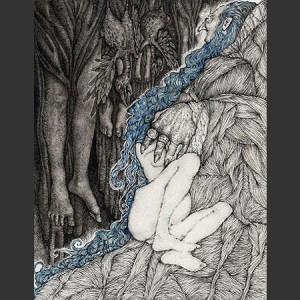 Fairy tales are simple and pure expressions of the collective unconscious and offer a clear understanding of universal patterns in the human psyche. The Bluebeard story in short goes as follows ~ Three sisters were courted by a noble man who had an unusual blue beard. Two of them were frightened of this blue beard, but the third one fell for his charm and married him. She may do whatever she wants in his absence, open every door in his huge castle, except one. But curiosity wins out. Encouraged by her sisters, she opens the forbidden door and sees the blood and dismembered corpses of Bluebeard’s previous wives. She understands what is in store for her. Once Bluebeard found out that she has seen the hidden chamber, he comes after her. “Please, allow me to compose myself and prepare for my death” she pleads and was granted a quarter of an hour. She has no intention of going quietly into her slaughter. She posts her sisters on the castle ramparts and shouts “Sisters, sisters, do you see our brothers coming?” And the brothers do show up, just in the nick of time, and kill Bluebeard “leaving for the buzzards his blood and gristle”.
Fairy tales are simple and pure expressions of the collective unconscious and offer a clear understanding of universal patterns in the human psyche. The Bluebeard story in short goes as follows ~ Three sisters were courted by a noble man who had an unusual blue beard. Two of them were frightened of this blue beard, but the third one fell for his charm and married him. She may do whatever she wants in his absence, open every door in his huge castle, except one. But curiosity wins out. Encouraged by her sisters, she opens the forbidden door and sees the blood and dismembered corpses of Bluebeard’s previous wives. She understands what is in store for her. Once Bluebeard found out that she has seen the hidden chamber, he comes after her. “Please, allow me to compose myself and prepare for my death” she pleads and was granted a quarter of an hour. She has no intention of going quietly into her slaughter. She posts her sisters on the castle ramparts and shouts “Sisters, sisters, do you see our brothers coming?” And the brothers do show up, just in the nick of time, and kill Bluebeard “leaving for the buzzards his blood and gristle”.
Just like a dream, a fairytale is not to be taken literally. It depicts the dance and the dynamics between the two grand archetypal forces, the masculine and the feminine, as they manifest in the collective as well as in the individual psyche. Both, dreams and fairy tales can be a kind of roadmap to discern an attitude that will allow, in fairy tale terms, for the princess to get her prince, and in Jungian language, for the union of opposites and the sacred marriage of the masculine and the feminine within ones soul.
Bluebeard is well and alive in the outer manifest world. In his densest form, a person, usually but not always, a male, becomes identified with Bluebeard’s energy and is then encountered, in the serial killer (yes, they do exist), the rapist, the human trafficker. Many of his victims won’t live to tell the story.
Even more prevalent is the sadistic, wife-beating husband. But Bluebeard also manifests through the man who is emotionally abusive. There is a violence that can be inflicted on a woman’s (AND the perpetrator’s) soul, which draws blood not from the physical but from the subtle body. This injury can be even more devastating than its physical counterpart. Sadly, it is ignored or played down by society. 
The emotionally abusive man is often a pathological narcissist, unwilling/unable to genuinely feel for anyone (including his own feeling self), although he can be sentimental and whiny when it comes to his own needs. Because he is disconnected from a nourishing center in psyche, he always needs to put himself, his ego, into the center of his own lonely universe. His alienation from the source forces the pathological narcissist to more and more drastic measures. He violently seeks to pierce through to a reality that will finally support him. That often leaves a trail of blood and corpses, sometimes symbolically, sometimes unfortunately literally. Horrifying in both instances.
But our naive heroine, who fell for the deadly charmer, survives and Bluebeard is dismembered and dead. But if a fairy tale is a map, what do we learn about the right kind of attitude to escape Bluebeard? A few things stand out for me. Naive the young woman may be, but not submissive and obedient. She wants to know. Only her disobedience allows her to survive. She becomes a warrioress for life  and lies to the lier. Like is cured by like. When she opened the door to the torture chamber, she truly sees. She does not escape into fantasies, as so many women in abusive relationships do, “It won’t happen to me, he really loves me, he will change”… and so on. Nor is she plagued by feelings of paralyzing shame for having been so terribly betrayed, (an irrational, but all-to-common response to abuse). When she sees, she knows, there is no more turning back.
and lies to the lier. Like is cured by like. When she opened the door to the torture chamber, she truly sees. She does not escape into fantasies, as so many women in abusive relationships do, “It won’t happen to me, he really loves me, he will change”… and so on. Nor is she plagued by feelings of paralyzing shame for having been so terribly betrayed, (an irrational, but all-to-common response to abuse). When she sees, she knows, there is no more turning back.
Her willingness and strength to face the truth is activating positive masculine energies in her, which manifest in her ability to sever the ties of Bluebeard’s seductive charm. Bluebeard’s power is fading. His dismemberment has begun. Her own inner masculinity is gaining muscle, which the fairytale depicts in the sudden appearance of brothers who put an end to Bluebeard. As an archetypal force he will not disappear, but in the life of this woman Bluebeard has no more hold over her.
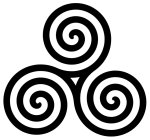
Addendum: The synopsis of the fairytale is based on the version printed in “Women who run with the Wolves” by the ever wonderful curandera, master storyteller and Jungian Analyst Clarissa Pinkola Estes. Her discussion of Bluebeard is illuminating and the entire book is a must read for any woman negotiating her own path.
For those interested in the psychological and mythological meaning of fairy-tales, I would like to point to the work of Marie-Luise von Franz, one of the most brilliant first generation Jungian Analysts who was a close collaborator with C.G.Jung himself. I particularly recommend “The Interpretation of Fairy Tales” and “Shadow and Evil in Fairy Tales”
The French director Catherine Breillart created a film version of “Bluebeard” in 2009, exploring the dark erotic bond characteristic of this particular dynamic, which might be of further interest.
A Glimpse into the Labyrinth of Relationships ~ C.G.Jung ~The Red Book Reflections
7 Comments
At times relationships can feel like a nightmarish war zone.  Whether the bond is romantic or sexual does not matter. Nor is it of any significance whether the partner is of the same or opposite sex. What matters is whether the “other” got under your skin. You know it when you feel it. An attraction, an affinity, a blissful roller coaster which can quickly break down all the coping strategies of a carefully created and nurtured persona. At times it may feel like madness knocking. That is not what we had in mind when we opened ourselves to another! Needs and emotions we never thought we had are gushing out of us. We may then find ourselves at a crossroads, though initially the choice of way is hardly in our control.
Whether the bond is romantic or sexual does not matter. Nor is it of any significance whether the partner is of the same or opposite sex. What matters is whether the “other” got under your skin. You know it when you feel it. An attraction, an affinity, a blissful roller coaster which can quickly break down all the coping strategies of a carefully created and nurtured persona. At times it may feel like madness knocking. That is not what we had in mind when we opened ourselves to another! Needs and emotions we never thought we had are gushing out of us. We may then find ourselves at a crossroads, though initially the choice of way is hardly in our control.
One thing that might happen is that all our defenses kick in and we regain what feels like ground under our feet. The inner whirlwind of affect is warded off ~ at the cost of our soul’s longing for a true connection to the inner other. The notion that there is an inner other, imaged and personified as a being of the opposite sex is at the core of Jungian thought. At first the ego knows nothing about this dynamic. But psyche needs to become conscious of herself. This evolutionary push towards consciousness is archetypal, it simply is. If we resist it, we will be dragged along, kicking and screaming and raging at the world. If we accept this archetypal urge towards consciousness, we can learn to breathe through the ride, as bumpy as it may be. Jung expresses this notion of the inner other in the Red Book (RB) as follows: “You, man, should not seek the feminine in women, but seek and recognize it in yourself….you, woman, should not seek the masculine in men but assume the masculine in yourself”.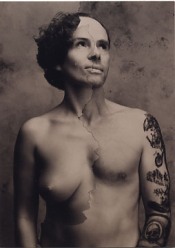 Psyche is bisexual. This is entirely unrelated to our sexual identifications. How do we then learn about the other within us? We unconsciously put (project) our unknown self onto another person. What we experience when these dynamics are enacted is a strong emotional reaction to another person. We might be irritated, repulsed, ticked off, but mostly, for better or worse, we might fall in love.We cannot help it because, as Jung says, “You are a slave of what you need in your soul”.
Psyche is bisexual. This is entirely unrelated to our sexual identifications. How do we then learn about the other within us? We unconsciously put (project) our unknown self onto another person. What we experience when these dynamics are enacted is a strong emotional reaction to another person. We might be irritated, repulsed, ticked off, but mostly, for better or worse, we might fall in love.We cannot help it because, as Jung says, “You are a slave of what you need in your soul”.
Let us consider the other direction at our crossroads. No doubt the less comfortable one, as the soul’s way always is. Welcome to our brave soul’s battle in her adventure of connecting to spirit. Because ultimately it is through the contrasexual archetype that the world beyond ego, the transpersonal, spiritual dimension opens up to us. “The part that you take over from the devil – joy -leads you into adventure”. How might one read this statement in the context of relationships? I opt to offer the following: to not resist the pull of your emotions, to make room for your love and hate and all the shades in between them, without allowing the emotional storms to take over. Not to be overtaken is often the hardest part and may require practice and support. Most important, however, is to never lose sight that while our attention is entirely hooked on the other person, we are always exploring and learning about ourselves. We are always reaching for and touching on an aspect of ourselves in the other.
Because ultimately it is through the contrasexual archetype that the world beyond ego, the transpersonal, spiritual dimension opens up to us. “The part that you take over from the devil – joy -leads you into adventure”. How might one read this statement in the context of relationships? I opt to offer the following: to not resist the pull of your emotions, to make room for your love and hate and all the shades in between them, without allowing the emotional storms to take over. Not to be overtaken is often the hardest part and may require practice and support. Most important, however, is to never lose sight that while our attention is entirely hooked on the other person, we are always exploring and learning about ourselves. We are always reaching for and touching on an aspect of ourselves in the other. 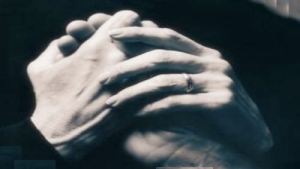
Jung allows us a glimpse into the awkward and raw experience of his soul’s journey towards his feminine side. Writing from a man’s perspective in general and his own very private, subjective one in particular, Jung notes: “It is bitter for the most masculine man to accept his femininity, since it appears ridiculous to him, powerless and tawdry”. A woman’s experience will be different, but in most cases she will also struggle with her acceptance of the masculine within herself. This is when love can turn into hate. Because “he” is so dominant, so controlling, so violent, so insensitive etc. “He” may be all of that but these qualities may lie dormant in the woman’s psyche, unbeknown to her, but usually experienced by others. “The feminine in man is bound up with evil…..the masculine in the woman is bound up with evil”. Not an easy statement to swallow, “Therefore people hate to accept their own other”, Jung continues. The darkness of what we experience as evil feels too much to own and therefore needs to be projected on the one we are close. Remember a time when the one you loved turned into a monstrosity? I do.
“But if you accept it….that when you become the one who is mocked the white bird of your soul comes flying. It was far away but your humiliation attracted it” Jung writes. Only then can we claim to be a complete person. Only then can we venture into relationship. On one hand a relationship into the amoral world of the archetypal cosmic psyche and the other hand into a fully fleshed out relationship with another person. Only then may we be able to see and love the person for who they are.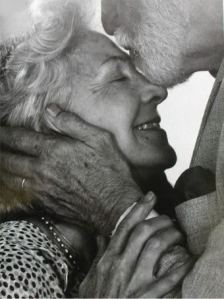
Oh yes, said Eve to the serpent, lead me into temptation. For I want to know.

Tags: C.G. Jung, Depth Psychology, emotions, eros, feminine, hate, love, madness, masculine, psyche, relationships, soul, spirit, The Red Book
“Downwards is the only way Forwards” ~ INCEPTION ~ A Jungian Perspective
1 Comment
 Worlds collapsing on itself, upwards, downwards, forwards, gravity no more. Narratives weave themselves in and out and around the globe. What the hell is going on here? What is reality? Ego wants to know.
Worlds collapsing on itself, upwards, downwards, forwards, gravity no more. Narratives weave themselves in and out and around the globe. What the hell is going on here? What is reality? Ego wants to know.
I am emerging out of the fluid and often violent scenery of the movie “Inception”. Be warned, if you have not seen the film, not much of what I am saying will make sense. If you have seen the film, you will probably have given up on the need to make sense. If that is the case, congratulation ~ the film has already succeeded. Welcome to the world of process, dreams and to the dream we call life as it presents itself just a few breaths below the threshold of waking consciousness. Memories, dreams, reflections is not only the title of Jung’s so-called autobiography but also the stuff we perceive as reality. Dare we drop the guard, tilt, fall and swim? Will we drown in chaos and random meaninglessness?
Leonardo DiCaprio, in the role of Cobb, a professional invader of the mind and corporate raider is both the heroic action protagonist and the subject of the trajectory of intercepting dream sequences. As in life, outer and inner are seamlessly intertwined. In Jungian terms, the personal and the archetypal overlap, feed each other and it is only our ego that needs to separate these two dimensions of experience.
At the core of the film we are witnessing Cobb’s journey to the roots of his feelings of guilt. He believes he planted (incepted) thoughts into his wife’s mind which led to her demise and suicide. He is aided in his descent by a young woman, Ariadne, recommended by this late wife’s father, who is the architect of the imaginal dream landscape. In Greek mythology, Ariadne helps the hero Theseus escape a deadly labyrinth, only to be betrayed and abandoned by him shortly afterwards. (My previous post, “Ariadne and the Minotaur” might be of interest). In some versions of the myth Ariadne kills herself.
The Ariadne in Cobb’s life (dream) may be another aspect of his inner feminine, just as is Mal, his late wife. Who are the figures that populate our waking dream of life?  Where is the intersection of outer reality and our psyche’s projection on her journey home to the center? Psyche expresses herself not only in visual image and affect, but also in sound. Repeatedly we hear Edith Piaf’s voice “Non , je ne regrette rien” ~ “No , I don’t regret anything” as if another aspect of the feminine responded to Cobb’s feelings of guilt. Oh, and of course, whoever saw “La vie en Rose” will remember that Edith Piaf was brought back to life, truly it appeared, by Marion Cotillard, who portrays Mal, Cobb’s wife and source of his guilt. Whose reality are we experiencing? Are you in my dream am I in yours? Layer upon layer ~ circling around a center ~ the mandala of the forever revolving life.
Where is the intersection of outer reality and our psyche’s projection on her journey home to the center? Psyche expresses herself not only in visual image and affect, but also in sound. Repeatedly we hear Edith Piaf’s voice “Non , je ne regrette rien” ~ “No , I don’t regret anything” as if another aspect of the feminine responded to Cobb’s feelings of guilt. Oh, and of course, whoever saw “La vie en Rose” will remember that Edith Piaf was brought back to life, truly it appeared, by Marion Cotillard, who portrays Mal, Cobb’s wife and source of his guilt. Whose reality are we experiencing? Are you in my dream am I in yours? Layer upon layer ~ circling around a center ~ the mandala of the forever revolving life.
In other versions of Ariadne’s myth, she does not commit suicide, but Hermes interferes and reunites Ariadne with her true husband Dionysus. The great God Hermes, the patron of depth psychology is the bringer of dreams. Like Cobb himself, Hermes is a thief and a messenger from the archetypal realm, a shapeshifter and protector of travelers, the guide of souls into underworld, the protector of boundaries and also the one who blurs them. When inner and inner outer world bleed into each other, it is Hermes who stands at the gate.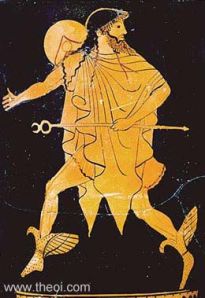
In Jungian thought we are not the creators of our thoughts, ideas and dreams. We are the vessels which receive them. But “someone had to create the dream” Cobb remarks. Hermes may bring us the dreams but who created them?
This questions leads to the most interesting image in the film. The image of the spinning top. A small object in Cobb’s possession which, as long as it is there and spins, serves as a reminder that he is in a dream. It is an anchor to not lose ones footing in the forever shifting shapes of perceptions and projections.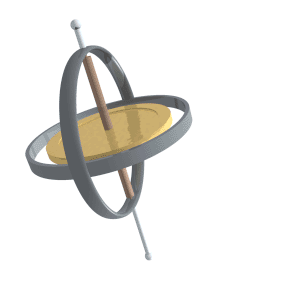 The gyroscope comes to mind and the Dreidel in Jewish culture. The gyroscope is a device for measuring and maintaining orientation. Its applications include navigation when magnetic compasses do not work, as in the Hubble Telescope.
The gyroscope comes to mind and the Dreidel in Jewish culture. The gyroscope is a device for measuring and maintaining orientation. Its applications include navigation when magnetic compasses do not work, as in the Hubble Telescope.
 The Dreidel is a four-sided spinning top. Each side of the Dreidel is covered with a letter of the Hebrew alphabet which together form the acronym for “a great miracle has happened here”. The word Dreidel itself comes from “dreyen” and means to turn. (info & images of gyroscope & Dreidel are from Wikipedia).
The Dreidel is a four-sided spinning top. Each side of the Dreidel is covered with a letter of the Hebrew alphabet which together form the acronym for “a great miracle has happened here”. The word Dreidel itself comes from “dreyen” and means to turn. (info & images of gyroscope & Dreidel are from Wikipedia).
If there is a device to navigate cosmic space, do we have an equivalent for inner space? Jung certainly thought so and this inner dynamic is contained in the image of the Mandala.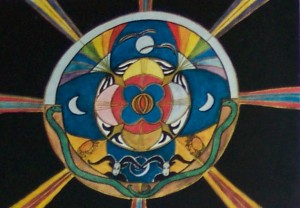 The mandala is NOT a static image. It depicts a turning, spinning and spiraling motion around a centering pole. It is a correspondence of the cosmic Tree of Life. Many cosmologies viewed this image and dynamic as a reflection of the creator matrix we call God. As above so below.This dynamic is at the center of our psychic life. As long as it spins, the great miracle of life holds us together as we forever dream downward and forward on humanity’s journey back home to the center.
The mandala is NOT a static image. It depicts a turning, spinning and spiraling motion around a centering pole. It is a correspondence of the cosmic Tree of Life. Many cosmologies viewed this image and dynamic as a reflection of the creator matrix we call God. As above so below.This dynamic is at the center of our psychic life. As long as it spins, the great miracle of life holds us together as we forever dream downward and forward on humanity’s journey back home to the center.

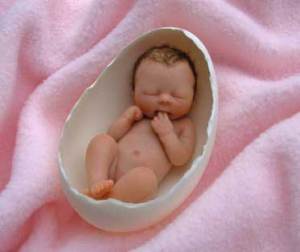
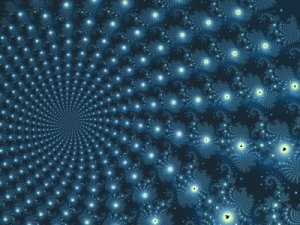 than what is represented by that terrible otherness of the psychopath that we feel we are no part of?
than what is represented by that terrible otherness of the psychopath that we feel we are no part of?
